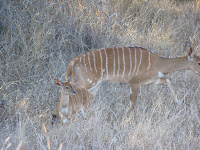 |
| Male Nyala. |
These cautious and characteristic antelopes can live up to 19
years in the wild if not caught by predators or succumbing to illness. Their natural predators being lions, leopards and wild dogs
while baboons and birds of prey hunt their young.
Both have a vertical white stripe running along their back, several
white stripes along their sides and a white mark between their eyes. Males are
much larger than females and have a distinctive pair of spirally horns with no
pigment on the tips. They have a longish mane of hair running down the back of
their necks, down their throats and chest area. The males are grey in colour
and have bright yellowish legs while females and juveniles are reddish brown.
Habitat
These antelopes are native to southern Africa, found not
only in South Africa but in other countries such as Malawi, Mozambique, Swaziland, Zimbabwe, Botswana and
Namibia.
Nyala’s live in the dense bush or on the borders of forests
close to water. They are not territorial animals often sharing the same water
source or grazing in the same area.
Behaviour
Nyala’s are attentive and wary antelopes, who make a sharp,
high, bark-like sound to alert others in the group to danger approaching. They
will also react to the alert calls of other animals such as impalas, baboons
and kudus. These antelopes have a white under tail marking which they display as
a warning sign to others.
Females form groups often with related members whereas adult
males prefer to live alone. Herds usually browse and drink water together in
their groups for safety. Their groups may range in size from two to ten antelopes,
sometimes breaking up and forming again.
Diet
These antelopes have a herbivore diet munching on a variety
of foliage, fruits, flowers and twigs and grazing on fresh grass during the
rainy season. The males use their impressive spiralled horns for digging, while
both sexes use their hooves to dig up their food. They prefer to eat in the cooler
parts of the day; early mornings or late afternoons. Nyalas’ are never far from
a water source as they need a daily drinking session.
 |
| Female Nyala with offspring. |
Reproduction
Females reach sexual maturity at a year old and males at 18
months of age. They breed throughout the year but mating takes place mostly in spring
and autumn. Males compete for dominance using their horns in fights. They may
also thrash bushes with their horns before or after fighting to demonstrate
strength.
The mother gives birth to a single calf after a gestation
period of 7 months and keeps them in hiding for 18 days. The calf will stay by
their mother’s side only leaving when the next calf is born, but often never
straying far.
Did you know?
They are shy animals
Have large ears with great hearing but poor eyesight

No comments :
Post a Comment